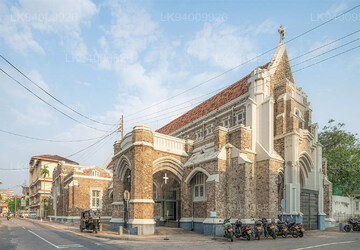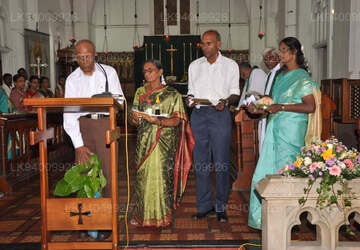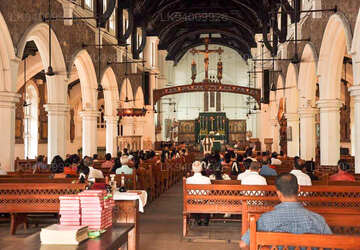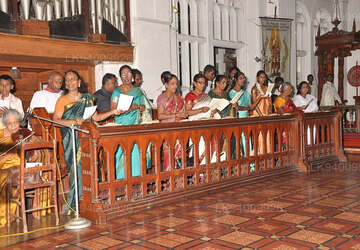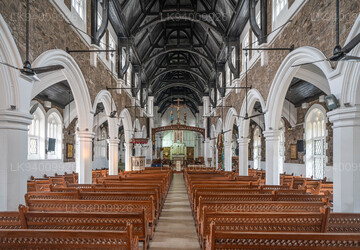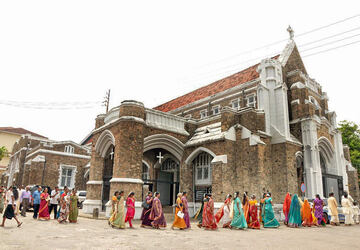St. Michael and All Angels
The Spreading of Christianity in Sri Lanka
Between the 15th and 20th centuries AD, Sri Lanka had a spate of foreign invasions. Once a free and proud nation ruled by kings, it became a conquered country that bowed to its white conquerors. The Portuguese, the Dutch, and the British invaded one after the other, fighting each other for a piece of the lush riches of the tropical island. Sri Lanka, then called Ceylon, remained in the hands of foreigners until the mid 20th century (4th of February 1948 to be exact).
The foreign invaders brought their guns, their ships, but also their religions. As they spread their language, their architecture, their style of clothing, and their ways of trade; they also spread their religions. They were all Christians but from different sects. To them converting the ‘savages’ was a mission given to them by God. The Portuguese were strictly Roman Catholic and forced the locals to convert once they captured most of Sri Lanka in the 16th century. They used the destruction of the local religious artifacts to establish their power and control.
The Dutch had converted to the Protestant sect by the time they invaded in the mid 17th century and therefore were very anti-Catholic. They destroyed all structures left by the Portuguese as much as possible or built over them. They forced as many Catholics to convert to Protestantism. While the local religions were left untouched, they won no favor with their huge taxes.
After the two invasions the local peoples were left exhausted, despairing and hopeless. Their resistance to the invaders was fading. Kandy was the last stronghold holding out. They too were being weakened from the inside by strife and betrayals. It was in such a situation that the British took over the country. Though Kandy was able to repel them at first, they also swiftly fell. The British didn’t use force to spread their religion. They were diplomatic used coercion and persuasion.
Those who converted to the Anglican sect received a better education, better job opportunities, better facilities, and most importantly the attention of the British. The British initially only paid attention to semi European Burghers and high caste natives, wooing them into converting their religions to Anglican and persuading them to support the British. This caused some jealousy and ill feelings towards the favored and spurred on the average locals. It had them vying to make sure that the British noticed them too. Then realizing that converting would earn them favors, some of the more enterprising and ambitious normal locals started converting on their own. Some more were converted through missionary work by the British pastors who had come to Sri Lanka. This was especially true for communities who were extremely poor, and receiving facilities and help through the missionaries.
And so, Christianity became a religious mainstay of the island.
The Need for a Church – 1844
Those who became Anglicans during the British era received further facilities, faster entry into schools for their children, higher chances for promotions at work, and much more. But they were still not treated as equals. The British had their own separate churches that they only allowed other white Anglicans into. Locals were not welcome. Therefore the locals had to make their own churches and shrines, for which they sometimes received assistance from the British missionaries and sometimes didn’t.
As it happened, during the mid 19th century there was a community of launderers in the village of Polwatte (now the Kollupitiya / Colombo 03 area), which received its name from the coconut palms there at the time. They started getting a missionary coming over to do some work with them, and many soon converted. By1844, the minister of Kotahena, Rev. Solomon David, came over regularly and held Service in a small house set aside for this sole purpose. Shortly afterward, Polwatte received a separate catechist stationed there.
The First Chapel – 1853
By the 1850s the congregation was getting too big for the house where the service occurred. In 1853, the first chapel in Polwatte was dedicated to St. Thomas by Bishop James Chapman. He called it a ‘godly Church in this secluded spot, unseen and unpraised of men’. The chapel was essentially a small wattle and daub hut roofed by palm leaves, and was located near the present junction of Hudson’s Road and Mohandiram’s Lane.
Being roofed with dry leaves resulted in a disaster in 1864, when the leaves caught on fire during a fireworks celebration for the chapels anniversary celebration. The entire structure burnt to the ground.
The New Chapel – 1865
The burning proved to be for the best, as the congregation had outgrown the site. The place was abandoned, and the church purchased a plot of land immediately adjoining the launderers’ drying space from the Government at the time. This was to become the site of the current Church of St. Michael and All Angels.
The new chapel was built in 1865, but was described as ‘bare and uninviting’. There was some slight improvement in 1867 when the chapel was enlarged and dedicated to Saint Thomas on the 21st December, his festival day. The official title then became ‘St. Thomas’ Chapel, Kollupitiya’. There was still no resident priest. It was managed by, Rev. G. Wikramanayake, Missionary in charge, and by a catechist who lived in the village. There were 30 communicants on the roll, and the total congregation of the Church was about 200, most of them being locals.
The Archdeacon and the Renaming – 1886/1887
In 1886, Archdeacon Matthew was transferred from Kandy to Colombo. He took over the parishes of Colombo South District; which at the time included Galkissa (Mount Lavinia), Milagiriya (Colombo 4), Timbirigasyaya (Colombo 5), and Polwatte (Colombo 3). He noticed the need for improvement in the little Chapel of St. Thomas in order to make it into a more effective unit. He was the driving force behind the Services in English and to alteration of the name. It was initially planned to be named ‘the Church of the Good Shepherd’, but then this name was the one that was decided on by the congregation. The Church was dedicated on St. Michael’s Day, on the 29th of September, 1887 in the hope that ‘the obedience and devotion of the Holy Angels might be imitated by all who worship in it – hence giving it the name ‘The Church of St Michael and the Holy Angels’. Rev. P. B. Moonemale was appointed as the first resident priest and in 1896 two aisles were added to the church.
The Parish Separates – 1899
Until the end of the 19th century there were very close relations between St Michaels and S. Peter’s in the fort. They formed one parish along with the Milagiriya Church. However, in 1999, the churches of St. Paul’s, Milagiriya (along with the Church of the Good Shepherd, Timbirigasyaya) and St. Michael’s chose to separate from St Peter’s and form two new parishes.
The Enlargement of the Church
Almost 20 years of peaceful worship followed. Then in 1918, the Colombo Harbor started to be built. Unable to stand the dust and the noise, people started migrating from Mutual to the nearby Cinnamon Gardens and Kollupitiya area. Those that had been parishioners elsewhere began frequenting St Michaels. The church became overcrowded and was unable to handle the number of people.
As a result, in 1918 the decision was made to expand the church. They soon realized however that simply expanding it would not be sufficient, and decided to build an entirely new church building. The initial part of the church was The first part of the new church was consecrated by Bishop Ernest. A. Copleston on 20 November 1919. He went on to consecrate the nave in the final fully complete structure on the all-important St Michael’s Day in 1922. This is how the church was built as it is today.
The Architecture
The Church of St Michael’s and All Angels had its walls made of hewn granite with mortar. All the statues and the door frames are made of pale granite as this was the rock to be found in the area. Therefore the craft that the architects have shown in bringing about a smooth elegant finish is amazing to see. The vaulted ceilings supported by old dark wooden roof beams, the broad arch with the figure of Jesus, and the beautiful cloistered nave are a sight for sore eyes. Some of the other things to see are the stained glass windows, the fine perpendicular tracery of the East window, and the Organ, Lady Chapel the High altar, and other accessories that were gifted at the time of building.
Also keep an eye out for the old stone engraving from the time that the church was built, that dedicates the church to St Michael.
Whether you’re Christian, or a history buff, or a simple sightseer, The Church of St Michael and All Angels in Kollupitiya has much to offer you. So don’t forget to drop by.

